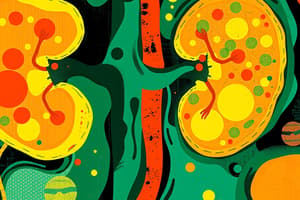Podcast
Questions and Answers
What is the purpose of the acidic buffer in urine protein testing?
What is the purpose of the acidic buffer in urine protein testing?
- To turn the color of the indicators from yellow to green
- To maintain a pH of 3.0 for the indicators (correct)
- To prevent the acceptance of hydrogen ions by proteins
- To decrease the sensitivity of albumin to the reagent pad
Which type of proteinuria involves selective filtration due to damage in the glomerulus?
Which type of proteinuria involves selective filtration due to damage in the glomerulus?
- Tubular proteinuria
- Orthostatic proteinuria
- Microalbuminuria
- Glomerular proteinuria (correct)
What causes the color change in indicators from green to blue in urine protein testing?
What causes the color change in indicators from green to blue in urine protein testing?
- Alkaline pH due to the presence of albumin (correct)
- Acidic pH of the urine sample
- Presence of heavy metals in the urine
- Acceptance of hydrogen ions by proteins
What does a color progression from green to blue indicate in urine protein testing?
What does a color progression from green to blue indicate in urine protein testing?
Which protein is considered most sensitive to the reagent pad in urine testing?
Which protein is considered most sensitive to the reagent pad in urine testing?
In which type of proteinuria does tubular dysfunction play a role?
In which type of proteinuria does tubular dysfunction play a role?
Which physiological type of proteinuria is associated with prolonged standing?
Which physiological type of proteinuria is associated with prolonged standing?
Why does albumin have a strong interaction with reagent pads in urine testing?
Why does albumin have a strong interaction with reagent pads in urine testing?
What causes proteins to gradually decrease in Orthostatic Proteinuria?
What causes proteins to gradually decrease in Orthostatic Proteinuria?
Which condition can lead to development of diabetic nephropathy and cardiovascular disease?
Which condition can lead to development of diabetic nephropathy and cardiovascular disease?
Flashcards are hidden until you start studying
Study Notes
Quality Control for Reagent Strips
- Run quality control when opening a new bottle or when obtaining questionable results
- Manual methods can be done using tablets or liquid chemicals when questionable results are obtained or when the urine is highly pigmented
Urine Glucose
- Double sequential enzymatic reaction involves two enzymes: glucose oxidase and peroxidase
- Reagent strip contains a mixture of glucose oxidase, peroxidase, chromogen (indicator), and buffer
- Procedure:
- Mix urine specimen thoroughly
- Never allow strip to remain in urine for extended periods
- Never forget to blot the edge of the strip after dipping
- Compare color reactions of the dipstick with the color chart horizontally
- Use good light source
- Never interchange reagents strips and color charts from different manufacturers
- Allow refrigerated specimen to return to room temperature before using reagent strips
- Protect reagent strips from deterioration caused by moisture, volatile chemicals, heat, and light
- Store at room temperature below 30°C, but never refrigerated
- Never use past the expiration date
Reaction Interferences
- False (+) results can occur due to:
- Hydrogen peroxide
- Urine container contaminated with detergents
- False (-) results can occur due to:
- Ascorbic acid
- High level of ketones
- High specific gravity of urine
- Low temperature
- Prolonged standing of urine
Copper Reduction Tests for Glucose
- Rely on the ability of glucose and other reducing substances to reduce copper sulfate to cuprous oxide in the presence of alkali and heat
- Color change from negative blue to green, yellow, orange, and red
- Tests that utilize this principle:
- Benedict's Test
- Copper sulfate
- Sodium carbonate
- Sodium citrate buffer
Chemical Examination of Urine
- Chemical examination of urine validates physical aspects of urine analysis
- Reagent strips (dipsticks) are a sensitive and rapid procedure
- Reagent strip:
- Narrow strip of plastic with small pads attached to it
- Each pad contains reagents for different reactions, allowing for simultaneous determination of several tests
- Colors generated are compared against a brand-specific color chart
Technique for Using Reagent Strips
- Dip reagent strip briefly into well-mixed urine at room temperature
- Remove excess urine by touching the edge of the strip to the container upon withdrawal
- Blot the edge of the strip into an absorbent pad
- Wait for the specified amount of time
- Compare the color reaction of each pad to the manufacturer's color chart
- Run with positive and negative controls every 24 hours at the beginning of each shift
Urine Protein
- Protein error indicators:
- Tetrabromphenol blue
- Tetrachlorophenol or Tetrabromsulfonphthalein
- Acidic buffer maintains pH of indicators at 3.0, giving them yellow coloration in the absence of proteins
- Proteins (primarily albumin) accept hydrogen ions from the indicator, altering the pH and turning the color from yellow to green to blue, depending on the amount of proteins
- Color is reported in terms of negative, trace, 1+, 2+, 3+, 4+
Renal Proteinuria
- Glomerular proteinuria:
- Selective filtration is impaired due to damage in glomerulus (e.g., lupus, erythematosus, and streptococcal glomerulonephritis)
- Tubular proteinuria:
- Tubular dysfunction (e.g., heavy metal poisoning, Fanconi syndrome, and viral infection)
- Microalbuminuria:
- Development of diabetic nephropathy and cardiovascular disease
- Orthostatic/postural proteinuria:
- Physiologic type due to prolonged standing, increased glomerular pressure, and ability of proteins to cross over
- Common in jobs that require prolonged standing
Studying That Suits You
Use AI to generate personalized quizzes and flashcards to suit your learning preferences.




